-
-
-
-
-
Currency
food-drink
10 Easy Vegetarian Christmas Mains (That Your Family Won’t Roast You For)


We might be living in the golden age of plant-based menu options, but somehow that food revolution doesn’t always make it to family Christmas.
It’s why so many of us end up having a serve of trifle for dinner and explaining to mum (again) that no, vegetarians don’t eat seafood.
This year we want to fill your dinner plate with something more substantial than custard while avoiding the stale tofurky jokes (and the actual tofurky). These new classics are big on taste and drama, but low on animal products and carbon impacts. Because who says a vegetarian can’t be the star of your family potluck?
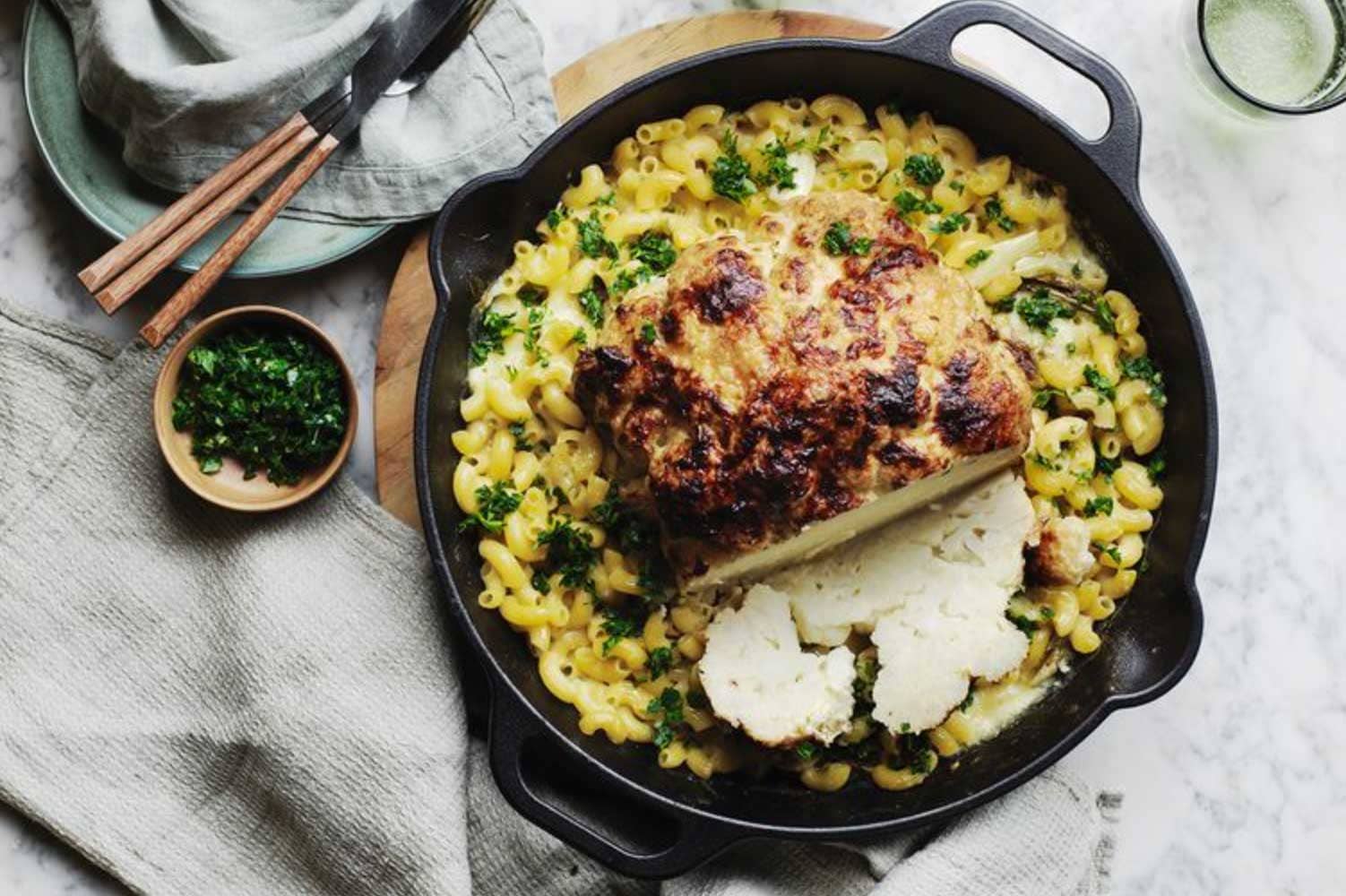
Documented By: delicious.
Whole-roasted cacio e pepe cauliflower
It’s not a meat-free mains round without a whole roast cauliflower. We’re not sure when this humble brassica became the glazed ham of the plant-based world, but we’re here for it. Mix things up a little with this cacio e pepe inspired spin.
Recipe by delicious.
Whole-roasted cacio e pepe cauliflower
Serves 4 people
Ingredients
1 large head cauliflower, trimmed, tender leaves removed, sliced and reserved
250g dried elbow pasta
100g unsalted butter, melted
1/2 bunch flat-leaf parsley, leaves picked, stems finely chopped
200ml creme fraiche
200g finely grated parmesan
2 garlic cloves, crushed
220g tub bocconcini, drained, roughly torn
2 tsp freshly ground black pepper
Zest of 1/2 lemon, plus juice to taste
Method
Preheat oven to 220°C.
Place whole cauliflower in a microwave-safe bowl. Drizzle with a little water and cover with plastic wrap. Microwave on high for 10 minutes or until tender. Carefully transfer to a metal tray and set aside to cool slightly.
Meanwhile, cook pasta in a saucepan of boiling salted water for 2 minutes less than packet instructions. Drain. Return to pan and toss through half the butter. Keep warm.
Place parsley stems, creme fraiche, parmesan, half the garlic and half the bocconcini in a bowl. Toss to combine. Set aside.
Place remaining butter and reserved cauliflower leaves in a large roasting pan. Top with cauliflower. Rub cauliflower all over with the cheese mixture, pushing it between the florets. Season with salt flakes and black pepper. Roast for 15 minutes or until the cheesy crust browns. Spoon cooked buttered pasta and remaining bocconcini around cauliflower, mixing the leaves through, and roast for a further 8-10 minutes until golden brown and pasta is warmed through.
Chop parsley leaves and place in a bowl. Add zest, remaining garlic and a squeeze of lemon juice, tossing to combine. Spoon over pasta and season with extra black pepper to serve.
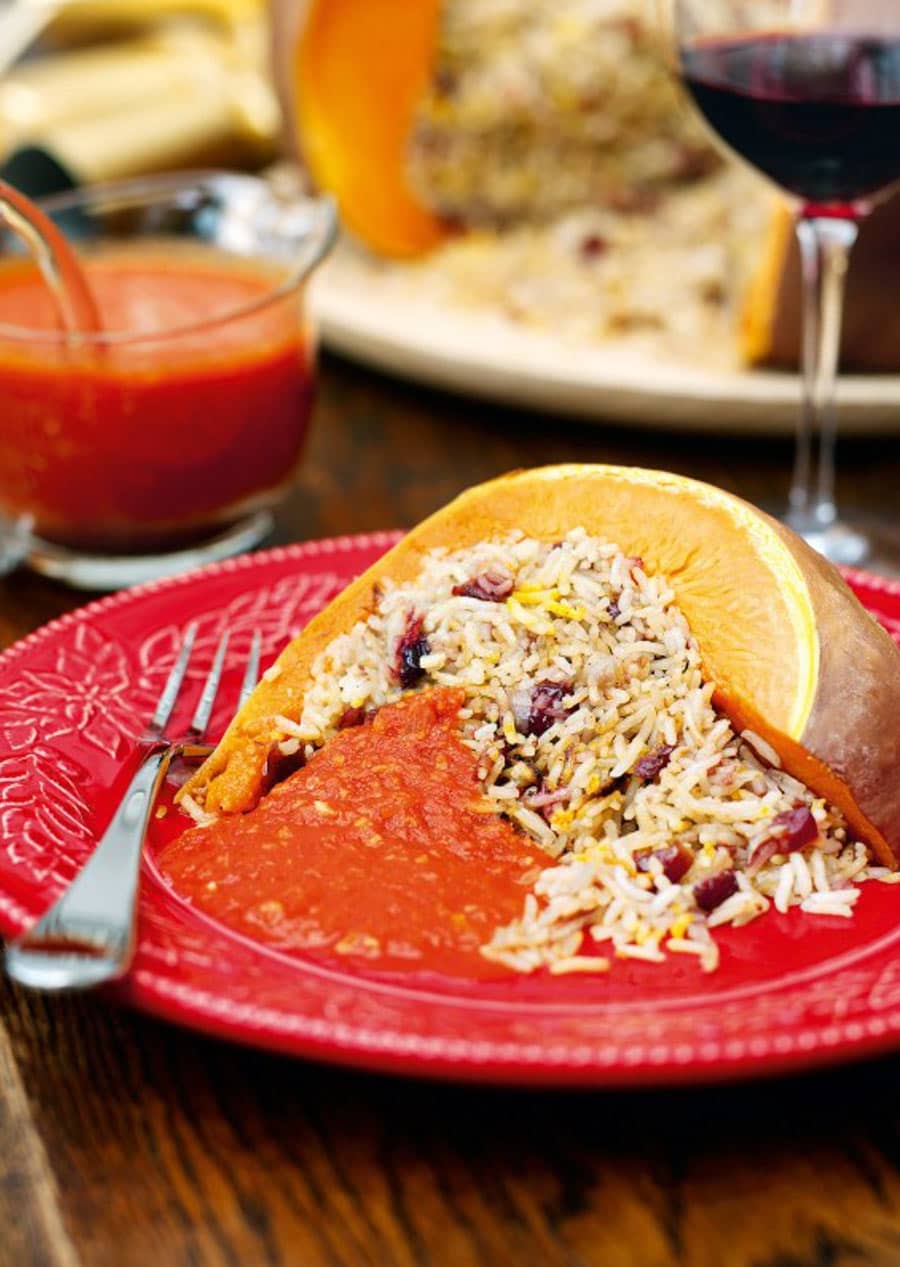
Documented By: Lis Parsons
Roast stuffed pumpkin with ginger tomato sauce
Whole cauliflower might be the current main character of vegetarian dining, but it took the crown from long-standing workhorse the roast stuffed pumpkin. Nigella Lawson’s take on the classic makes things feel especially festive with a healthy dose of Christmas flavours.
Recipe by Nigella Lawson
Roast stuffed pumpkin with ginger tomato sauce
Serves 8–12 people
Ingredients
For the roast stuffed pumpkin:
1 x 3½ kilograms pumpkin, preferably French pumpkin
1 onion (finely chopped)
1 tablespoon vegetable oil (or olive oil)
3 cloves garlic (2 minced, 1 left whole)
150 grams dried cranberries
1 teaspoon ground ginger
1 teaspoon ground allspice
1 good pinch of saffron strands
zest of 1 clementine
approx. 400 grams basmati rice
approx. 1 litre hot vegetable stock
salt and pepper (to taste)
For the gingery tomato sauce:
1 onion (peeled and halved)
2 cloves garlic (peeled)
1 teaspoon ground ginger
1 x 3 centimetres piece of fresh ginger (peeled)
2 tablespoons olive oil
700 grams tomato passata
500 millilitres water
1 teaspoon caster sugar
salt and pepper (to taste)
Method
Preheat the oven to 200°C/180°C Fan/gas mark 6/400ºF. Slice a lid off the top of the pumpkin, and remove the seeds and fibrous flesh from the inside, keeping the top to put back on later.
In a large saucepan (with lid), fry the onion gently in the oil until softened, then add the 2 minced garlic cloves, the cranberries, spices and clementine/satsuma zest. Stir in the rice, turning till it becomes glossy in the pan.
Pour in the stock and let the pan come to the boil, then clamp on the lid and turn the heat down to the lowest it will possibly go. Cook for 15 minutes.
Cut the remaining clove of garlic in half and rub the inside of the pumpkin with the cut side of each half, then, using your fingers, smear some salt over the flesh inside as well.
The rice stuffing will be quite damp and not very fluffy at this stage, but check it for seasoning — adding more spice, salt or pepper if wanted — and then spoon it into the garlic- and salt-rubbed pumpkin cavity and tamp down well. Press the pumpkin lid back on top and squeeze it down as firmly as you can (it will sit up a bit proud of the top).
Stand the pumpkin on a double layer of foil, wrapping the foil 4cm / 2 inches up around the sides and scrunching it there, to keep the pumpkin out of direct contact with the water later.
Place the stuffed, partially wrapped pumpkin in a roasting tin and pour in freshly boiled water to a depth of 2cm / 1 inch. Cook the pumpkin for about 2 hours by which time it should be tender when pierced.
Meanwhile, get on with the gingery tomato sauce.
Take the pumpkin out of the roasting tin and let it sit for about 10 minutes before you slice it into segments like a cake.
Put the onion, garlic, dried ginger and fresh ginger into a processor and blitz to a pulp.
Heat the oil in a deep, wide pan, then add the onion–garlic mixture. Cook over a low heat for about 10 minutes, stirring occasionally so that it doesn’t burn.
Add the passata and water to the pan, and season with the sugar, salt and pepper.
Cook for 15 minutes, at a gentle simmer, then taste for seasoning before decanting into a warmed jug or gravy boat and taking to the table, for people to pour over their slices of stuffed pumpkin.
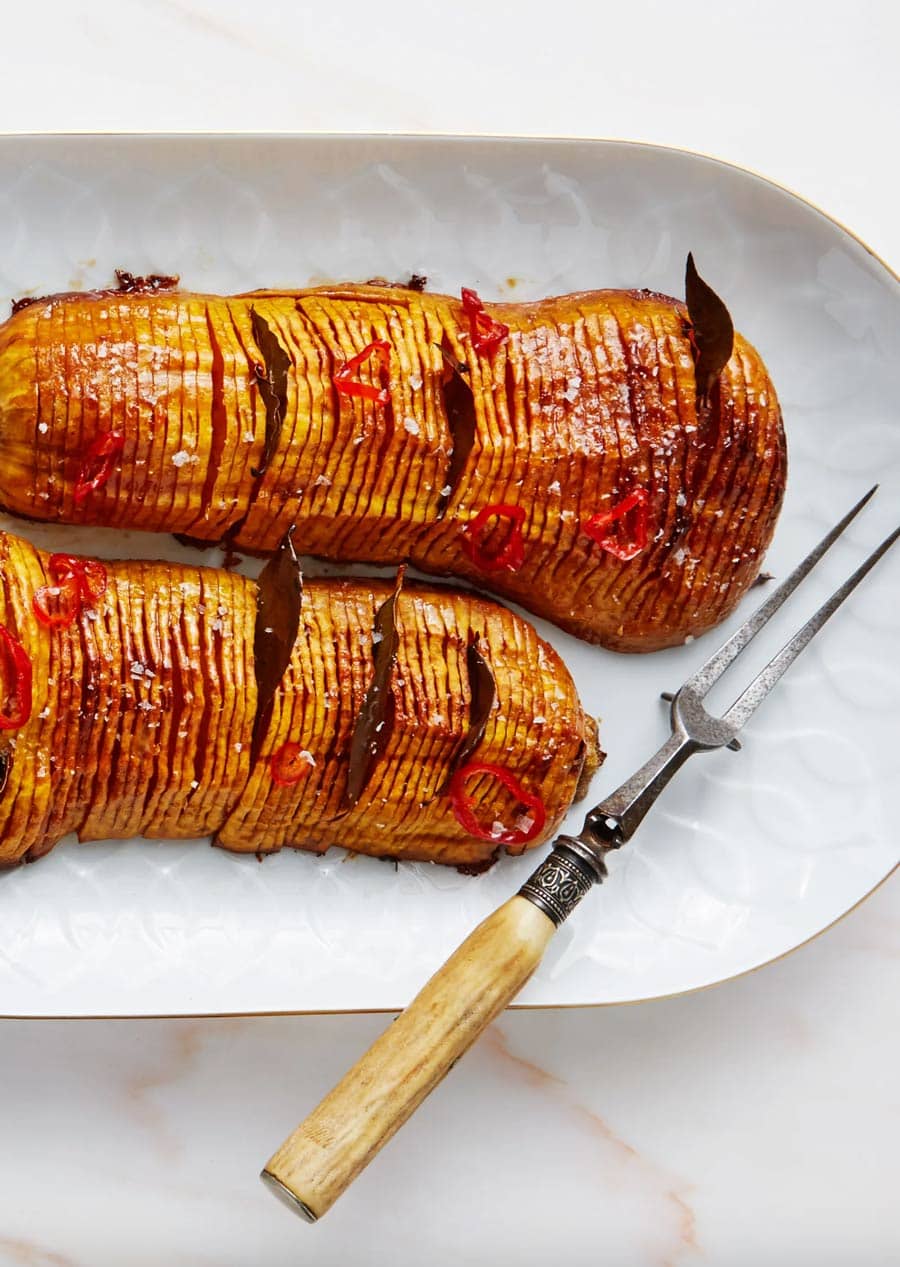
Documented By: Bobbi Lin
Hasselback butternut squash with bay leaves
If you love pumpkin but are after something slightly more modern (sorry, we love a stuffed veg but you get it) Bon Appetit are on hand with their signature low-key elegance. This hasselback butternut squash with bay leaves dish says, “I’m festive, sure.” But also, “I have other stuff to do this month.”
Recipe by Bon Appetit
Hasselback butternut squash with bay leaves
Serves 8 people
Ingredients:
1 large butternut squash or 2–3 small honeynut squash (about 3 pounds total)
1 tablespoon olive oil
Kosher salt, freshly ground pepper
1 Fresno chile, thinly sliced
¼ cup pure maple syrup, preferably grade B
3 tablespoons unsalted butter
2 tablespoons apple cider vinegar
6–8 dried bay leaves
Method
Place a rack in upper third of oven; preheat to 425°. Halve squash lengthwise and scoop out seeds with a large spoon. Using a peeler, remove skin and white flesh below (you should reach the deep orange flesh). Rub all over with oil; season with salt and pepper. Roast in a baking dish just large enough to hold halves side by side until beginning to soften (a paring knife should easily slip in only about ¼"), 15–18 minutes.
Meanwhile, bring chile, maple syrup, butter, and vinegar to a simmer in a small saucepan over medium-high, stirring occasionally and removing chile as soon as desired heat level is reached (set aside for serving), until just thick enough to coat spoon, 6–8 minutes. Reduce heat to very low and keep glaze warm.
Transfer squash to a cutting board and let cool slightly. Using a sharp knife, score rounded sides of squash halves crosswise, going as deep as possible but without cutting all the way through. Return squash to baking dish, scored sides up, and tuck bay leaves between a few of the slices; season with salt and pepper.
Roast squash, basting with glaze every 10 minutes or so and using pastry brush to lift off any glaze in dish that is browning too much, until tender and glaze forms a rich brown coating, 45–60 minutes. Serve topped with reserved chiles.
Do ahead: Squash can be roasted 4 hours ahead. Let cool until just warm; cover and store at room temperature. Reheat before serving.
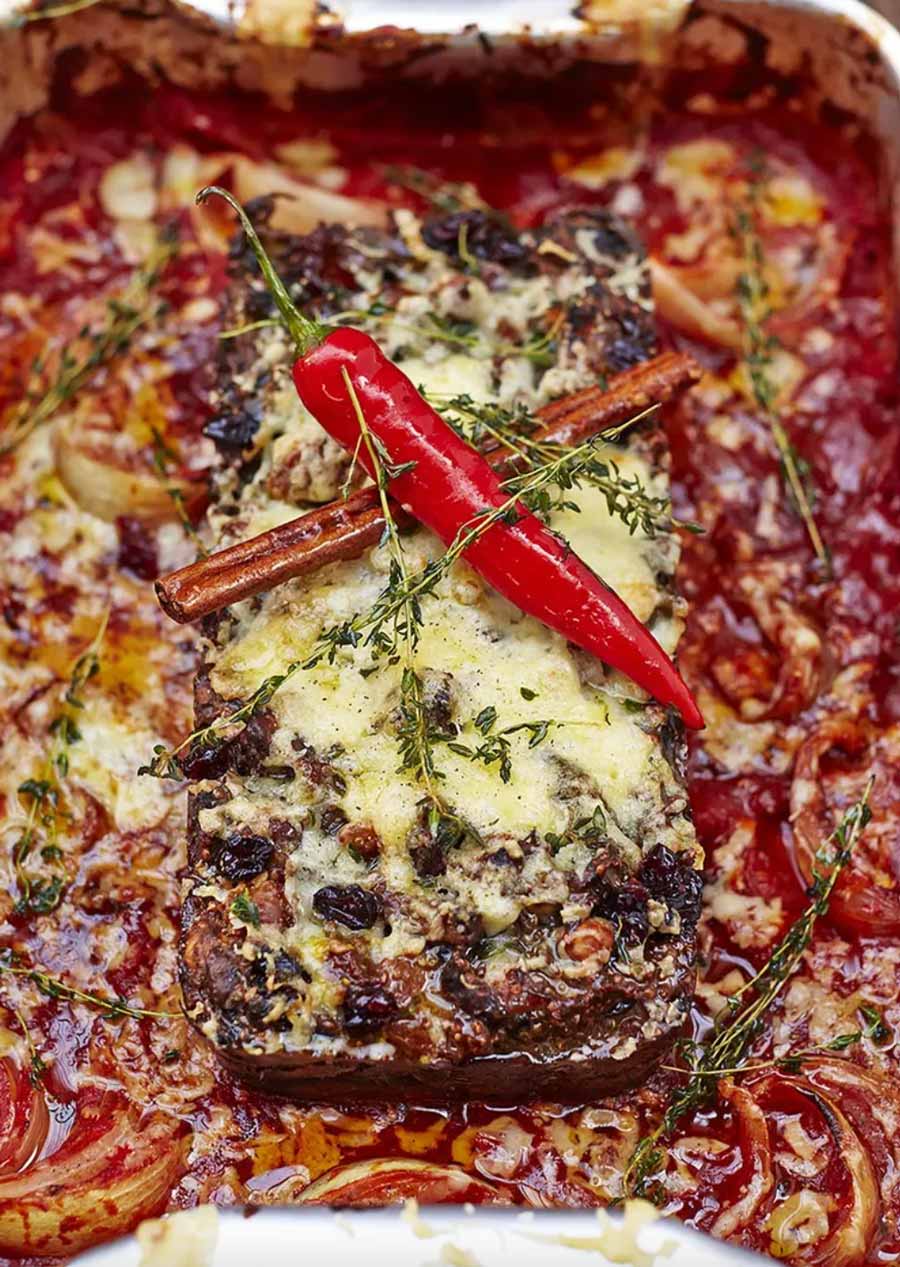
Documented By: Jamie Oliver
Nut roast with salsa rossa picante
On the subject of updated classics, nothing needed a makeover more than the nut roast. Move past your university memories of trying to make this infamously stodgy brick work, and place your trust in Jamie Oliver. The patron saint of saving dated recipes works his magic here by elevating the experience with a spicy tomato salsa.
Recipe by Jamie Oliver
Nut roast with salsa rossa picante
Serves 8 people
Ingredients:
4g unsalted butter, plus extra for greasing
10g quinoa
15g onion squash
1 onion
2 cloves of garlic
2 sticks of celery
olive oil
20g tinned or vac-packed chestnuts
2 sprigs of fresh rosemary
½ teaspoon cayenne pepper
1 pinch of sweet smoked paprika
1 teaspoon dried oregano
2 large field mushrooms
1 lemon
6g fresh breadcrumbs
8g dried cranberries
10g dried apricots
10g mixed nuts, such as walnuts, cashews, hazelnuts and brazil nuts
4 large free-range eggs
4g mature Cheddar cheese
Salsa Rossa Picante
2 fresh red chillies
1 stick of cinnamon
2 cloves of garlic
1 small onion
½ bunch of fresh thyme, (15g)
2 x 400 g tins of quality plum tomatoes
1 tablespoon balsamic vinegar
Method
Preheat the oven to 180ºC/350ºF/gas 4. Grease a 1-litre loaf tin with a little butter, then line with greaseproof paper.
Cook the quinoa according to the packet instructions, then set aside to cool.
Halve the squash, scoop out the seeds, then chop the flesh into rough 1cm chunks (you don’t need to peel the skin). Peel and roughly chop the onion. Peel and finely slice the garlic, then trim and roughly chop the celery.
Drizzle 2 tablespoons of olive oil into a large frying pan over a medium heat, then add the chopped vegetables and crumble in the chestnuts. Pick in the rosemary leaves, discarding the stalks, then toss well.
Add the cayenne, paprika and oregano. Season with sea salt and black pepper, stir well, then reduce the heat to medium-low. Cook for around 15 minutes, or until softened slightly.
Meanwhile, roughly chop the mushrooms, then add to the pan for the final 5 minutes of cooking.
Remove the pan from the heat, stir in the butter and grate in half the lemon zest. Transfer the mixture to a large bowl, then stir in the cooled quinoa, breadcrumbs, dried fruit and nuts (feel free to bash up some of the larger nuts if you prefer a less chunky consistency).
Crack in the eggs, then stir well to combine. Pop the mixture into the prepared loaf tin, then place in the hot oven for 45 to 50 minutes, or until cooked through and set.
When there’s about 30 minutes to go, make the salsa rossa. Place a roasting tray on the hob over a medium-low heat. Prick the chillies and add to the tray with a lug of olive oil and the cinnamon.
Peel and finely slice the garlic, peel and slice the onion into 8 wedges, then add them to the tray. Pick in most of the thyme leaves (save a few sprigs to one side).
Pour in the plum tomatoes and 1 tin’s worth of water, then stir well, breaking up the tomatoes with the back of a spoon. Season with salt and stir in the balsamic vinegar, then bring to the boil. Reduce the heat and simmer for around 20 minutes, or until thickened and reduced.
Once the salsa is ready, take 1 chilli out of the tray, then carefully halve, deseed and roughly chop it before returning it to the tray. Loosen the salsa with a splash of water, if needed, then pick out the extra chilli and cinnamon stick and put to one side.
Remove the nut roast from the oven, then carefully turn it out, peeling away the greaseproof paper. Pop the nut roast into the tray and grate over the cheese. Place the cinnamon stick, chilli and reserved thyme sprigs on top.
Return it to the oven for 10 to 15 minutes, or until bubbling and golden. Delicious served with mashed potato and seasonal greens.
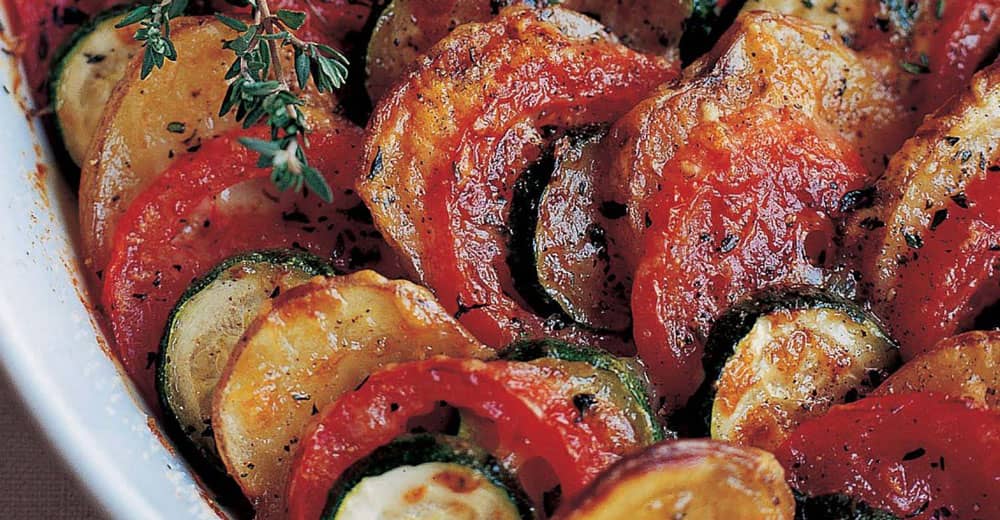
Documented By: Quentin Bacon
Vegetable Tian
Lets change speeds for a second. While we love a 21st century reboot, not all icons need to be reinvented. Some of them truly are perfect in their original form. Case in point: Ina Garten’s vegetable tian. Not only is it simple yet delicious, it will allow you to indulge in some light East Hampton cosplay.
Recipe by barefoot contessa
Vegetable Tian
Serves 4–6 people
Ingredients:
Good olive oil
2 large yellow onions, cut in half and sliced
2 garlic cloves, minced
1 pound medium round potatoes, unpeeled
3/4 pound zucchini
1-1/4 pounds medium tomatoes
1 teaspoon kosher salt
1/2 teaspoon freshly ground black pepper
1 tablespoon fresh thyme leaves, plus extra sprigs
2 ounces Gruyère cheese, grated
Method
Preheat the oven to 375 degrees.
Brush a 9 x 13 x 2-inch baking dish with olive oil. In a medium sauté pan, heat 2 tablespoons of olive oil and cook the onions over medium-low heat for 8 to 10 minutes, until translucent. Add the garlic and cook for another minute. Spread the onion mixture on the bottom of the baking dish.
Slice the potatoes, zucchini, and tomatoes in 1/4-inch-thick slices. Layer them alternately in the dish on top of the onions, fitting them tightly, making only one layer. Sprinkle with salt, pepper, thyme leaves, and thyme sprigs and drizzle with 1 more tablespoon of olive oil. Cover the dish with aluminum foil and bake for 35 to 40 minutes, until the potatoes are tender. Uncover the dish, remove the thyme sprigs, sprinkle the cheese on top, and bake for another 30 minutes, or until browned. Serve warm.

Documented By: Laura Murray
Tahdig With Cranberries and Woody Herbs
The secret ingredient for Christmas cooking is time and patience (wait, should we write a cookbook?). If you’re already committed to spending a few hours in the kitchen, why not knock out something you’ve been thinking of trying but never quite have the headspace for?
For us that’s an unctuous tahdig. Sohla El-Waylly’s take on the staple of many Iranian mum’s introduces some very relevant seasonal ingredients.
Recipe by Sohla El-Waylly
Tahdig With Cranberries and Woody Herbs
Serves 4–6 people
Ingredients:
2½ cups basmati rice, preferably sella
¾ cup plus ½ tsp. Diamond Crystal or 7 Tbsp. plus ¼ tsp. Morton kosher salt
½ cup ghee
⅓ cup unsweetened dried cranberries
2 sprigs rosemary
2 sprigs sage
2 sprigs thyme
Big pinch of saffron threads
1 tsp. sugar
1 large egg yolk
2 tbsp. plain whole-milk Greek yogurt
Method
Place rice in a medium bowl. Pour in cool water to cover and gently agitate grains with your hands; drain. Repeat process until water is almost clear, at least 2 more times. Cover again with cool water and let soak at least 15 minutes and up to 2 hours.
Bring ¾ cup Diamond Crystal or 7 Tbsp. Morton kosher salt and 3 quarts water to a rapid boil in a large nonstick pot. Drain rice and add all at once to pot (it will sink to the bottom). Stir a few times with a wooden spoon to prevent sticking, then stop stirring. Return water to a simmer and cook until grains are nearly doubled in size and most of rice is rapidly bubbling up to the surface, 3–7 minutes, depending on quality of rice. When you bite into a grain, you should see a small white core; grains should remain firm. Drain rice and rinse under cold running water until cool; reserve pot. Set rice aside.
Melt ghee in a small saucepan over medium heat. Add cranberries, rosemary, sage, and thyme and cook, stirring occasionally, until cranberries are plump and herbs frizzle and crisp, about 5 minutes. Using a slotted spoon, transfer cranberries and herbs to a plate. Set ghee aside.
Grind saffron and sugar with mortar and pestle to a fine powder. Add 2 Tbsp. hot water and stir to dissolve; set aside.
Mix egg yolk, yogurt, half of reserved ghee (scant ¼ cup), 1 Tbsp. saffron mixture, and remaining ½ tsp. Diamond Crystal or ¼ tsp. Morton kosher salt in a medium bowl. Add 1½ cups reserved rice and gently stir to combine. Transfer to reserved pot and spread in an even layer with a spoon. Arrange herbs on top. Using a large spoon, mound half of remaining rice on top in a small hill, taking care that rice does not touch the sides of pot. Top with cranberries, then mound remaining rice over. Using the handle of a wooden spoon or a chopstick, make a hole in the center of the mound all the way to just above tahdig (the bottom layer). This will help the steam circulate throughout the rice. Drizzle remaining saffron mixture and ghee over, followed by 2 Tbsp. water. Wrap lid with a kitchen towel; cover pot. Secure ends of towel to pot handles with rubber bands or twine.
Set pot over medium-high heat. Do not uncover at any point. Cook until sides of pot are very hot to the touch and you can hear the tahdig simmering, about 5 minutes. Reduce heat to medium-low and cook, undisturbed, until rice begins to smell toasty (but not burnt) and simmering sounds have subsided, 40–45 minutes. (If it’s your first time making tahdig, start checking for cues after 25 minutes. Timing can vary greatly depending on your pot and burners.) Remove lid; the rice should be fluffy and fully cooked. Using an offset spatula or fork, lift the bottom layer and take a peek to see if a crust has formed. If not, re-cover pot and continue cooking another 10 minutes. Once it has, remove pot from heat and let rice sit, covered, 10 minutes.
Uncover rice and scoop off mounded rice along with cranberries and herbs to a platter. Loosen rice crust with an offset spatula and either turn out onto another plate or break into large pieces in the pot and place atop rice, golden side up.
Do ahead: Rice can be parboiled 2 days ahead. Transfer to an airtight container; cover and chill. Bring to room temperature before using.
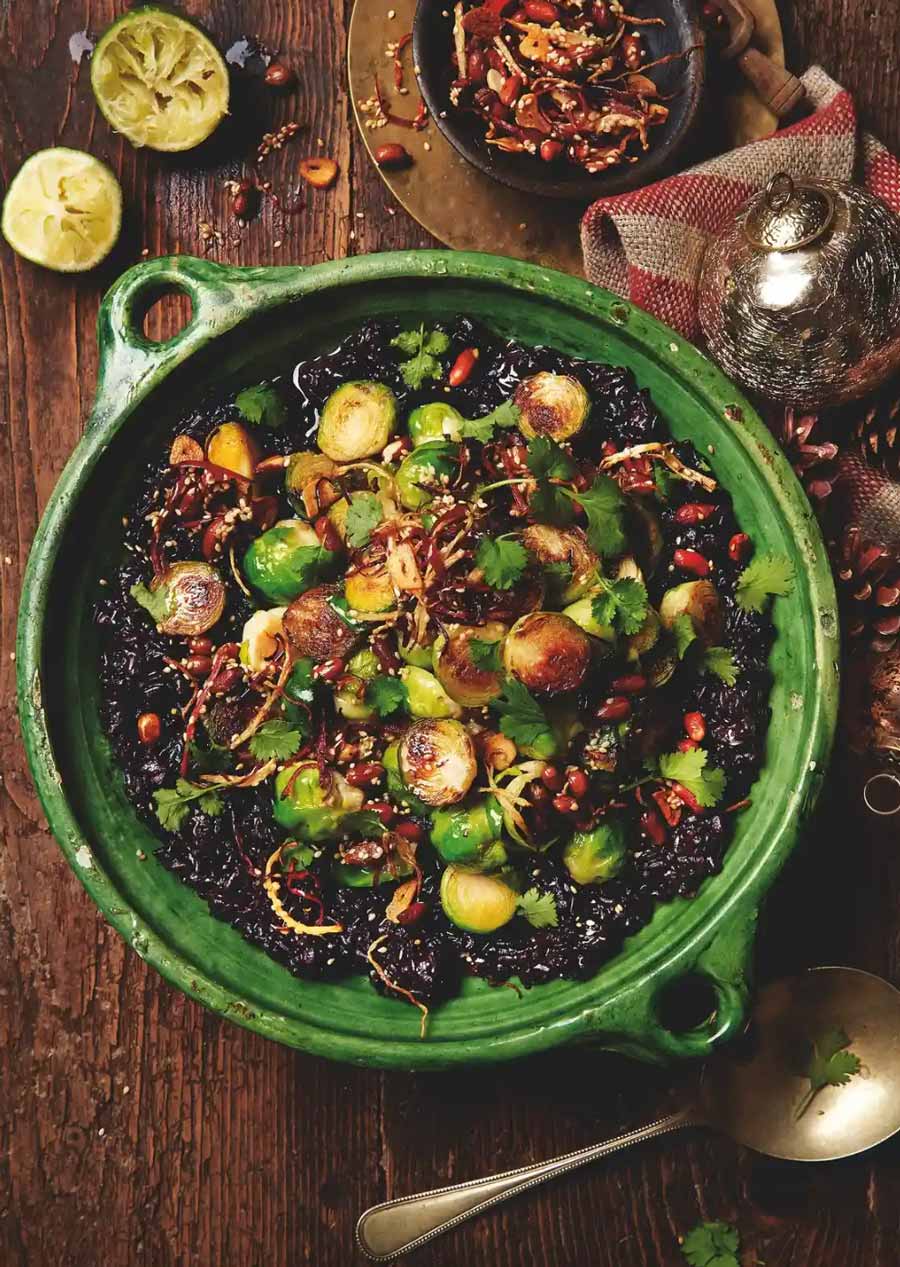
Documented By: Louise Hagger
Black miso sticky rice with peanuts and brussels sprouts
While we’re stepping out from the usual Western Europe traditions, consider checking in with the svengali of show-stopping vegetarian dishes, Yotam Ottolenghi. He’s a master of multiple meat-free Christmas moments, but our favourite is this unexpected but unforgettable marriage of Asian flavours and undersung veggies.
Recipe by Yotam Ottolenghi
Black miso sticky rice with peanuts and brussels sprouts
Serves 8 people
Ingredients:
700g Thai black rice
160g white miso
90ml rice vinegar
Salt
90ml groundnut oil
6cm piece ginger, peeled and julienned
5 red chillies, deseeded and julienned
5 garlic cloves, peeled and thinly sliced
120g small peanuts, skin on (or regular peanuts chopped in half)
2 tbsp toasted sesame seeds
1.2kg brussels sprouts, trimmed, cut in half lengthways (or quartered, if big)
½ tsp sesame oil
2 tbsp mirin
20g coriander leaves, roughly chopped
2 limes, halved
Method
Put the rice in a large saucepan with 1.8 litres water, the miso, two-thirds of the vinegar and a teaspoon of salt. Bring to a boil, then turn the heat to medium-low, cover and simmer gently for an hour, until very little liquid is left. Shake the pan every once in a while to stop the rice from sticking to the base. Take the pan off the heat, cover and set aside for 10 minutes, until the rice is cooked but still retains a bit of a bite; by this time, any remaining liquid should have reduced to the consistency of thick jam.
Heat the groundnut oil in a large nonstick frying pan over a medium-high heat, then fry the ginger, chilli and garlic for two minutes, until the garlic goes translucent. Add the peanuts, fry for three minutes more, until everything is golden-brown and crisp, then transfer to a small plate with a slotted spoon (you want to keep the oil in the pan). Mix the sesame seeds and an eighth of a teaspoon of salt into the peanut mix.
Return the pan to a high heat, add the sprouts and half a teaspoon of salt, and fry for six to eight minutes, stirring often, until the sprouts are dark golden-brown and starting to go crisp. Remove from the heat and stir in the sesame oil, mirin and remaining rice vinegar.
To serve, spoon the rice into a large, shallow serving bowl and top with the sprouts. Sprinkle over the coriander and squeeze over the lime juice, top with the crisp chilli and peanuts, and take to the table.
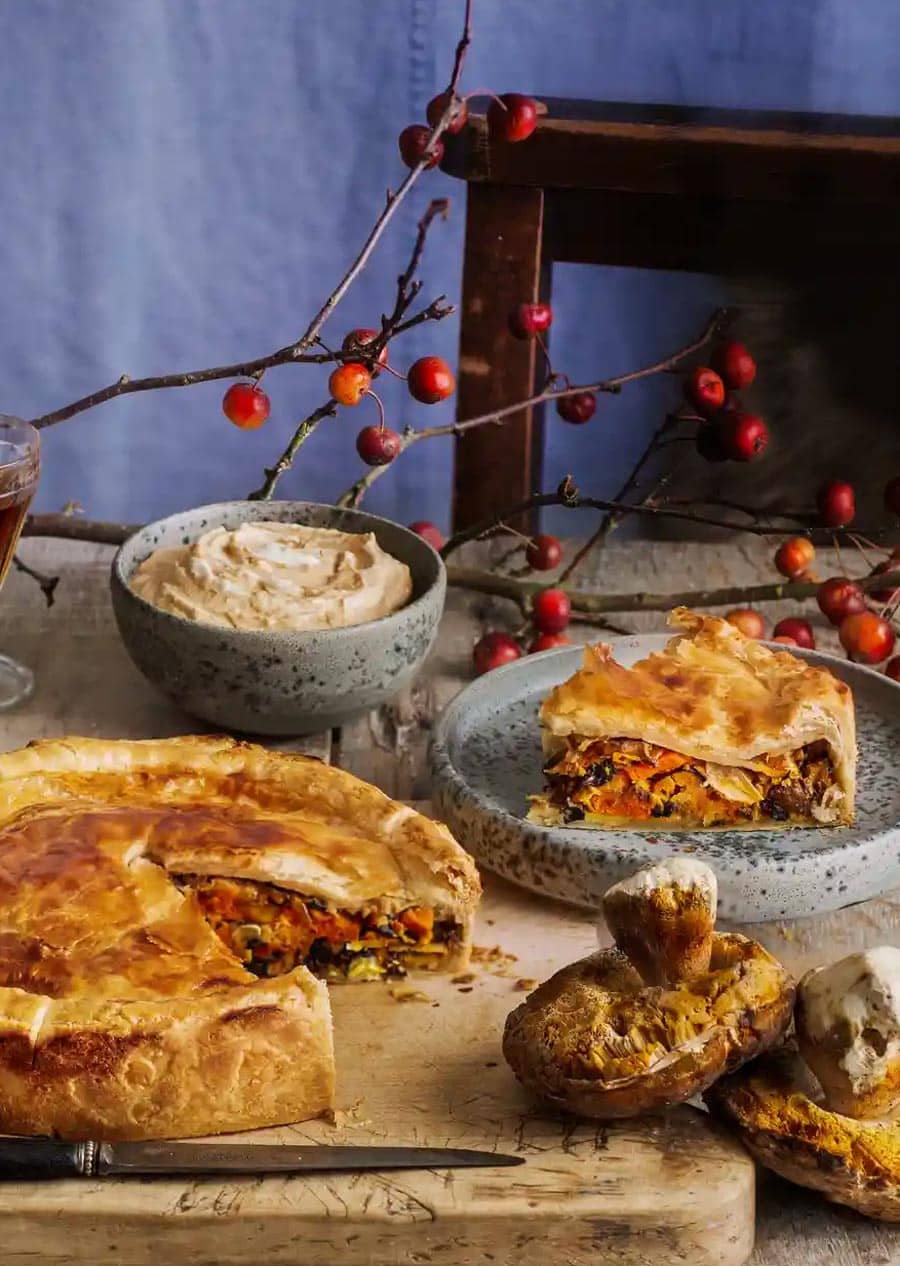
Documented By: Romas Foord/The Observer
Mushroom, kimchi and sweet potato pie with miso sour cream
We’ve got miso and sticky rice on the table. Let’s keep going with this umami tsunami by Bruno Loubet. The innovative French chef has built his career by colliding classic cuisine with daring new ingredient combinations, and he’s not pulling any punches here.
Recipe by Bruno Loubet
Mushroom, kimchi and sweet potato pie with miso sour cream
Serves 6 people
Ingredients:
450g sweet potatoes, peeled
200g wild mushrooms
160g (or 360g if you don’t have the wild mushrooms) large chestnut mushrooms
1 large red onion, peeled and finely sliced
2 cloves garlic, very finely sliced
50g butter, plus extra for greasing
275g (220g cabbage, 55g kimchi juice) kimchi cabbage
2 tsp potato flour
2 tbsp sour cream
1 egg
1 tbsp breadcrumbs
400g puff pastry
For the crepe mix, miso sour cream and egg wash
Crepe mix
50g plain flour
1 egg
60ml milk
2 tbsp parsely, chopped
1 tbsp chives, chopped
1 tsp tarragon, chopped
Miso sour cream
2 tbsp dark miso paste
6 large tbsp sour cream
Egg wash
2 egg yolks
2 tbsp milk
Method
Preheat the oven to 220C/gas mark 7. Cut the sweet potatoes into 5mm slices and place on a baking tray and bake for 15-20 minutes.
Meanwhile, chop the mushrooms in chunks and sauté in a frying pan with the red onion, garlic and butter until soft and lightly coloured then remove from the heat.
Cut the kimchi in small pieces and fry with its own juice and the mushrooms. Reduce the juices by half then add the potato flour. Mix well, then take off the heat. Leave to cool.
For the crepes, place the flour in a mixing bowl and make a well in the middle. In small bowl, whisk the egg with the milk. Slowly pour the egg mixture into the middle of the flour, but do not pour it all in. Use a whisk to bring a little of the flour in at a time. Keep whisking to avoid lumps.
When the mixture is still thick give a good whisk to break any lumps then add the remaining egg mixture. Whisk well and season to taste with salt and pepper. Whisk in the herbs.
In a lightly oiled 30cm frying pan, cook 2 large crepes, then set aside to cool on a plate.
Add the egg, sour cream and breadcrumbs to the cooled vegetables and stir well. Place into a mixing bowl. Crush the cooled sweet potato and mix into the other vegetables.
In a little bowl, whisk together the egg yolks and milk for the egg wash.
Roll out the puff pastry to 5mm thick, then cut 2 squares (1 slightly bigger than the other) to fit a deep 22cm cake tin. Grease the tin well. Lay the bigger sheet of puff pastry, pushing it into the bottom edge. Line with a crepe, trimming as necessary. then fill with the vegetable mix. Lay the other crepe over. Brush one side of the smaller remaining sheet of pastry with the egg wash, then place over the crepe, egg wash side down. Trim the corners with scissors to make it round and pinch around the edges to stick it together. Brush the top with the egg wash. With a small knife make a small hole in the centre of the pie for the steam to escape during the cooking.
Place in the oven and cook for 30 minutes then lower the heat to 170C/gas mark 3 and cook for another 15 minutes.
Make the miso cream by simply mixing the miso paste into the sour cream. Add black pepper to taste.
To serve, unmould the pie and place on a wooden board and cut at the table. Serve with the bowl of miso cream.
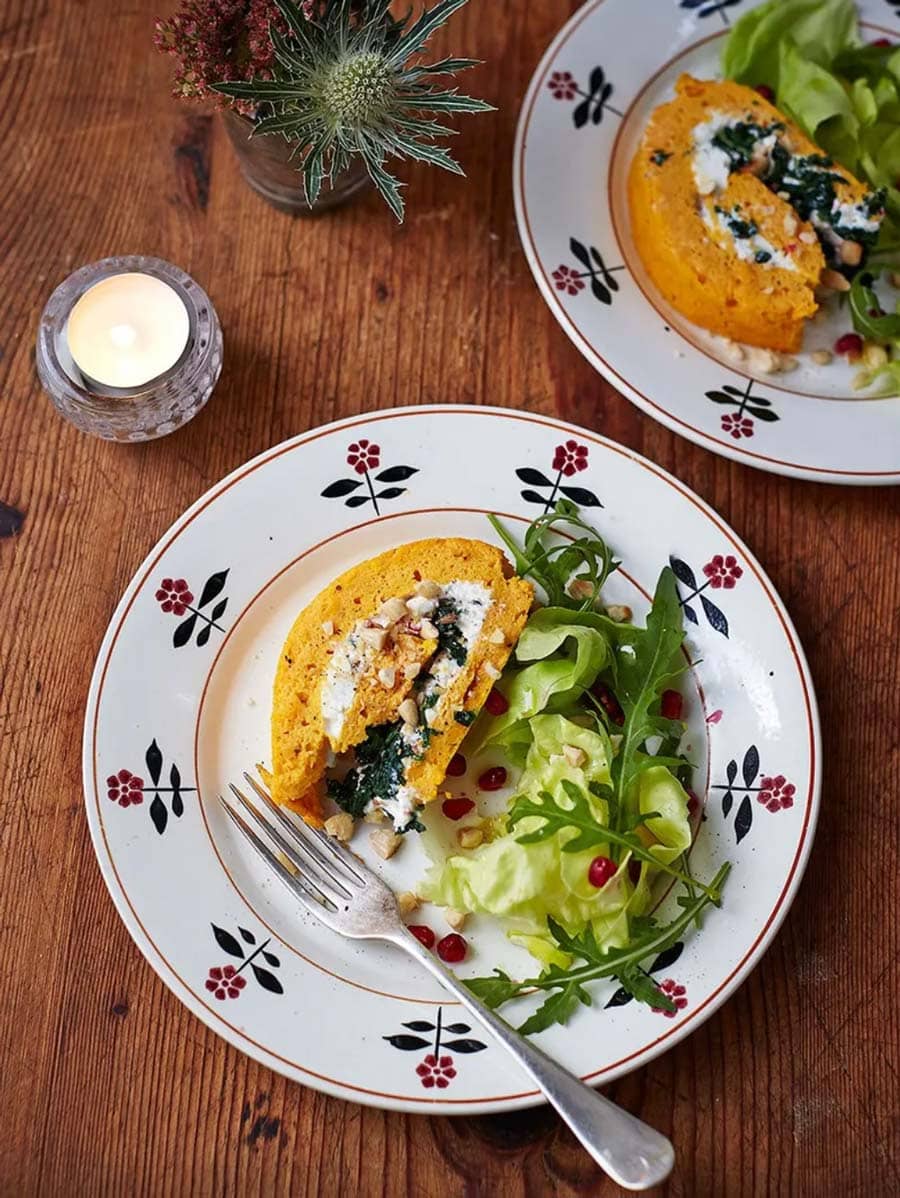
Documented By: Jamie Oliver
Gluten-free spinach & ricotta roulade with a butternut squash sponge
If we’re honouring under-served dietary requirements, then we need to take a moment to acknowledge our gluten-free brothers and sisters. This photogenic roulade respects temperamental tummies and is also pretty as a picture so will make the family photo album too.
Recipe by Jamie Oliver
Gluten-free spinach & ricotta roulade
Serves 6 people
Ingredients:
1 kg butternut squash
olive oil
1 pinch of chilli flakes
2 cloves of garlic
6g whole blanched almonds
1 teaspoon fennel seeds
6 large free-range eggs
8g Parmesan cheese
6g gluten-free plain flour
1 whole nutmeg, for grating
30g baby spinach
10g crumbly goat's cheese
15g ricotta cheese
1 lemon
1 fresh red chilli
Method
Preheat the oven to 190°C/375ºF/gas 5. Line a shallow baking tin (roughly 22cm x 32cm) with greaseproof paper.
Carefully halve the squash, scoop out and discard the seeds (there’s no need to peel it), then chop into rough 3cm wedges. Place into a large roasting tray with a splash of olive oil, the chilli flakes and a small pinch of salt and pepper. Toss to coat.
Bash and add the garlic cloves to the tray, then pop in the hot oven for 45 minutes to 1 hour, or until tender.
Meanwhile, place a frying pan over a medium heat, then add the almonds, fennel seeds and a pinch of salt. Cook for 3 to 4 minutes, or until golden (keep an eye on them!), then bash well in a pestle and mortar.
Take the squash out of the oven (keep the oven on for later). Scoop the flesh into a food processor and discard the skin. Squeeze the garlic cloves from their skins, add to the processor, then whiz to a smooth purée.
Separate the egg yolks from the whites into two large bowls. Grate the Parmesan over the yolks, then stir in the squash purée, flour, a good grating of nutmeg and a pinch of salt and pepper.
Whisk the egg whites to soft peaks in a separate bowl then carefully fold it into the squash mixture. Transfer to the lined tin, spreading it out evenly. Bake for 14 to 15 minutes, or until set and springy.
Meanwhile, heat a splash of olive oil in a large pan over a medium heat, then add the spinach and cook for around 2 minutes until wilted. Leave to cool, squeeze out the excess moisture, then finely chop.
Turn out the roulade onto a large piece of greaseproof paper. Carefully peel away and discard the top layer of greaseproof paper.
Crumble the goat’s cheese into a bowl, then add the ricotta, lemon zest and juice. Deseed, finely chop and add the chilli, stir well, then season to taste with sea salt and black pepper.
Spread the mixture over the sponge, leaving a rough 2cm gap along one of the longest edges. Scatter over the spinach and one-third of the almonds.
Starting at the longest edge with no filling, carefully roll up the sponge, using the greaseproof paper to help you.
Scatter over the remaining nuts, then carve into thick slices and serve straight away with a fresh green salad.
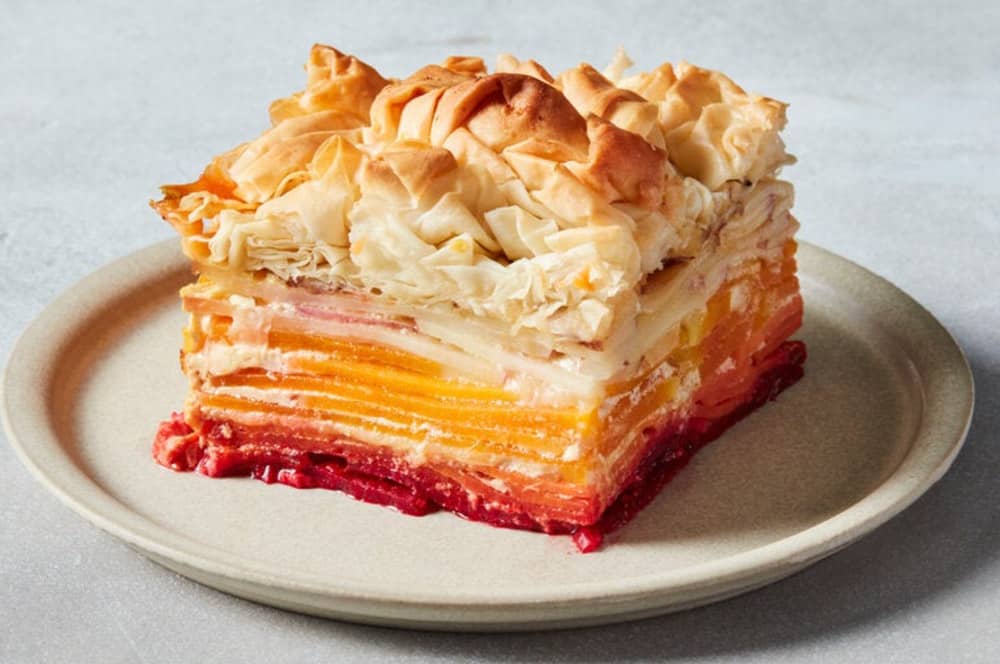
Documented By: Christopher Testani
Ombré Gratin
Finally, let’s not pretend looks don’t matter. Set the mood with a delicious centrepiece that’s so pretty everyone will be like, “What’s a turkey?”
Ombré Gratin
Serves 12 people
Ingredients:
For the cream
3 tablespoons unsalted butter, plus more for greasing the dish
1½ cups finely chopped shallots (from 4 large shallots)
8 garlic cloves, finely chopped
2 tablespoons whole black peppercorns
4 cups half-and-half
8 fresh or dried bay leaves
2 tablespoons fresh thyme leaves
¾ teaspoon grated nutmeg
1½ teaspoons kosher salt (such as Diamond Crystal)
3 large egg yolks
For the vegetables and the the phyllo top
2½ pounds red potatoes (about 6 medium red potatoes), scrubbed
Kosher salt (such as Diamond Crystal) and black pepper
2 large beets (about 6 ounces each)
10 ounces Gruyère, grated (about 4 cups)
2 large sweet potatoes (about 10 ounces each), peeled, halved lengthwise and sliced into ⅛-inch-thick slices (see Tip)
2 pounds butternut squash (the neck of 1 squash), peeled, quartered lengthwise and sliced into ⅛-inch-thick slices (see Tip)
½ cup plus 2 tablespoons/5 ounces unsalted butter
16 phyllo pastry sheets, thawed
Method
Set a rack in the middle of the oven and another right below it. Heat the oven to 375 degrees. Grease a 13-by-9-inch baking dish with butter; set aside.
Prepare the cream: In a large saucepan, melt the butter over medium-low. Add the shallots, garlic and black peppercorns and cook, stirring occasionally, until shallots are softened, about 5 minutes. Stir in the half-and-half, bay leaves, thyme, nutmeg and 1½ teaspoons salt and bring to a simmer over medium-high. Reduce the heat to maintain a low simmer and cook, whisking occasionally, until slightly thickened, about 20 minutes.
Strain the seasoned cream through a fine-mesh sieve into a large bowl. (You should have about 3 cups.) Return the cream to the saucepan off the heat. In the same bowl, whisk the egg yolks, then whisk in a few tablespoons of the warm cream, 1 tablespoon at a time, to temper the yolks. (Tempering prevents the cold yolks from scrambling when combined with the warm cream. The yolks will help your filling hold together.) Whisk the egg yolk mixture into the cream. Reserve and refrigerate 1 cup cream for serving. Rinse and dry the bowl.
Using a mandoline (or very sharp knife; see Tip), slice the unpeeled red potatoes crosswise ⅛-inch thick. In the bowl, toss the potatoes with 1½ teaspoons salt and ¾ teaspoon pepper until evenly seasoned, then stir the potatoes into the cream in the saucepan. (The warmth of the cream will help the potatoes start to cook.) Set aside.
Peel, trim and halve the beets, then slice them ⅛-inch thick using a mandoline (or very sharp knife; see Tip). Add the beets to the bowl and toss with ¾ teaspoon salt and ¼ teaspoon pepper. Shingle the sliced beets in the baking dish, overlapping slightly, in two even layers, then sprinkle them evenly with 1⅓ cups grated Gruyère. Wipe out the bowl to remove any beet juices.
In the bowl, season the sliced sweet potatoes with 1 teaspoon salt and ¼ teaspoon pepper; toss to coat. Shingle them on top of the cheese-topped beets in 2 to 3 even layers, then press them gently to compress the vegetables evenly, eliminating any air pockets. Sprinkle the sweet potatoes with 1⅓ cups grated Gruyère.
In the bowl, season the squash with ¾ teaspoon salt and ¼ teaspoon pepper; toss to coat. Shingle the squash over the cheese-topped sweet potatoes in 2 even layers, press to compress the mixture, then sprinkle the squash with the remaining 1⅓ cups grated Gruyère.
Shingle the potatoes on top in 2 to 3 even layers, then slowly pour the remaining cream mixture evenly over the sliced vegetables. Set on the middle rack of the oven and place a large sheet pan directly underneath on the rack below to catch any drips. Bake until the vegetables start to soften, about 1 hour.
After the vegetables have baked for about 40 minutes, prepare the phyllo: In a small saucepan, melt the butter over medium-low heat. Working on a large, clean surface, set 1 sheet of phyllo down. Brush lightly with melted butter then set a second sheet of phyllo on top. Take your hands and scrunch the phyllo into a 5½-inch rosette with lots of folds. Push aside, then repeat with remaining 14 sheets of phyllo, creating 8 rosettes total.
After the sliced vegetables have cooked for 1 hour, remove from the oven. Increase heat to 400 degrees. Using a paper towel, gently pat the surface to remove any liquid that may have risen to the surface, then cover the top with the 8 phyllo rosettes, scrunching them as needed to fit. Brush the phyllo generously with melted butter.
Bake until the phyllo is crisp and golden and the vegetables are tender and a paring knife slides easily through the center, about 30 minutes. Let cool for 20 to 30 minutes before slicing. (Patience is crucial; if you slice this before the liquids are reabsorbed, the gratin won’t form slices without slipping apart.)
While the gratin firms up, reheat the reserved cream over medium until warmed through, about 2 minutes. Season the warm sauce with salt and pepper.
To serve, cut the gratin in half lengthwise, then cut crosswise to form 12 even slices. Pass the sauce at the table, to spoon on the side.
Tip: In order for the vegetables to be tender by the time the phyllo is crispy and golden, they must be sliced ⅛-inch thick. A mandoline makes fast work of vegetable slicing and creates uniformly thin pieces, though you could use a very sharp knife (and an abundance of caution) when slicing the dense vegetables. Japanese Benriner slicers are restaurant staples, and are affordable tools for home cooks, too.

ABOUT US
CUSTOMER CARE
EDITORIAL & RIISE PRODUCTIONS
© 2021 RIISE, All Rights Reservedjoin riise's mailing list for 10% off your first order.Availability















